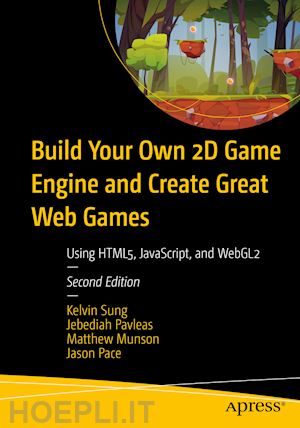
Questo prodotto usufruisce delle SPEDIZIONI GRATIS
selezionando l'opzione Corriere Veloce in fase di ordine.
Pagabile anche con Carta della cultura giovani e del merito, 18App Bonus Cultura e Carta del Docente
Develop a 2D game engine that will give you the experience and core understanding of foundational concepts for building complex and fun 2D games that can be played across the Internet via popular web browsers. This book is organized so that the chapters follow logical steps of building a game engine and integrates concepts accordingly.
Build Your Own 2D Game Engine and Create Great Web Games isolates and presents relevant concepts from software engineering, computer graphics, mathematics, physics, game development and game design in the context of building a 2D game engine from scratch. In this edition, all the code is based on updated versions of JavaScript with HTML5 and WebGL2: you will analyze the source code needed to create a game engine that is suitable for implementing typical casual 2D videogames. You will also learn about physics and particle system. The discussion of physics component includes rotations and popular physical materials such as wood, mud, and ice. The discussion of particle component has popular presets such as fire, smoke, and dust.
By the end of the book, you will understand the core concepts and implementation details of a typical 2D game engine, learn insights into how these concepts affect game design and game play, and have access to a versatile 2D game engine that they can expand upon or utilize to build their own 2D games from scratch with HTML5, JavaScript, and WebGL2.
What You Will Learn
Who Is This Book For
Game enthusiasts, hobbyists, and anyone with little to no experience who are interested in building interactive games but are unsure of how to begin. This can also serve as a textbook for a junior- or senior-level "Introduction to Game Engine" course in a Computer Science department.
Chapter 1: Introduction
Sub-Topics
· Introduction to the IDE
· Development environment setup· Guide to use the book
· References
Chapter 2: Working with HTML5 and WebGL2
Sub - Topics
· HTML5 canvas for drawing
· Project organization
· Elementary drawing with WebGL2
· Abstraction with JavaScript objects
· Working with shaders and controlling the color
Chapter 3: Transformation and World Coordinate
Sub-Topics:
· Renderable: encapsulating drawing
· Transforming a renderable object
· Encapsulating the transform operator
· View and projection transform and the viewport
· The camera
Chapter 4: Common Components of a Game Engine
Sub-Topics:
· The game loop
· Keyboard input
· Resource management and asynchronous loading
· Game levels and scene files
· Scene objects
· Audio support
Chapter 5: Working with Texture, Sprites, and Fonts
Sub-Topics:
· Texture mapping and texture coordinates
· Drawing with sprite sheets
· Sprite animations
· Fonts and drawing of text
Chapter 6: Behaviors and Collisions
Sub-Topics:
· Abstraction of game objects
· Elementary behavior: chasing
· Collision between game objects
· Per-pixel accurate collisions
Chapter 7: Camera Manipulations
Sub-Topics:
· Basic camera manipulations
· Manipulation with interpolations
· Camera shake effect
· Working with multiple cameras
· Mouse input through the cameras
Chapter 8: Illumination and Shadow
Sub-Topics:
· Ambient light
· Point light sources
· Multiple light sources and distance attenuation
· Diffuse reflections and normal mapping
· Specular reflections and materials
· Directional and spot lights
· Simulation of shadows
Chapter 9: Physics
Sub - Topics:
· Physics engine and rigid shapes
· Broad-phase collision detection· Collision information and separation axis theorem
· Collision between rectangles and circles
· Movement and symplectic Euler integration
· Resolving collisions
· Support for rotations
· Physics engine presets: wood, mud, ice, and dirt
Chapter 10: Particle Systems and Stenciling
Sub-Topics:
· Particles and effects
· Particle emitters
· Particle system presets: fire, smoke, snow, dust, and explosion
· Stencils
Chapter 11: Supporting Camera Background
Sub-Topics:
· Tiling of the background
· Motion parallax
· Layer management
Chapter 12: Building a Sample Game: From Design to Completion
Sub-Topics:
· Game concept and design
· Integrating a setting: layout and playable space
· Additional elements: interaction model and audio











Il sito utilizza cookie ed altri strumenti di tracciamento che raccolgono informazioni dal dispositivo dell’utente. Oltre ai cookie tecnici ed analitici aggregati, strettamente necessari per il funzionamento di questo sito web, previo consenso dell’utente possono essere installati cookie di profilazione e marketing e cookie dei social media. Cliccando su “Accetto tutti i cookie” saranno attivate tutte le categorie di cookie. Per accettare solo deterninate categorie di cookie, cliccare invece su “Impostazioni cookie”. Chiudendo il banner o continuando a navigare saranno installati solo cookie tecnici. Per maggiori dettagli, consultare la Cookie Policy.